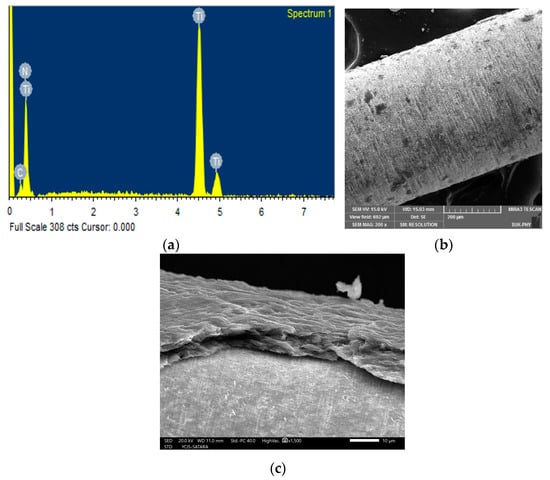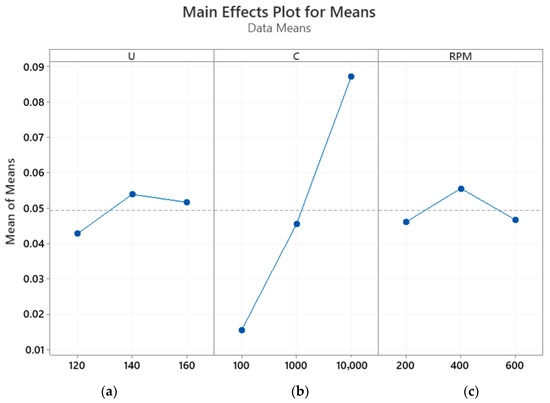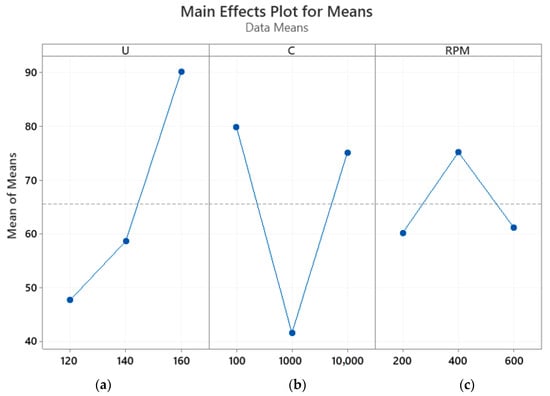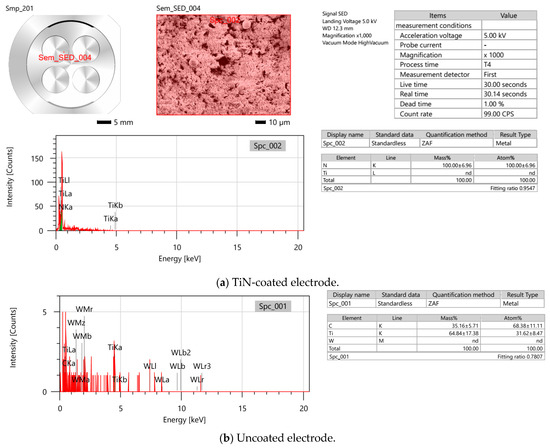Abstract
Micro-electrical discharge machining (micro-EDM) stands out as a transformative methodology, offering substantial progress in both technical and economic efficiency through the integration of coated electrodes. This study meticulously analyzes various technological parameters in micro-EDM, focusing specifically on Ti-6Al-4V, a widely employed titanium alloy. The application of a titanium nitride (TiN) coating material on a tungsten carbide (WC) electrode is investigated using the Taguchi method of experimental design. This study employs an ANOVA and factorial design methodology to scrutinize the influence of key parameters, namely voltage (V), capacitance (C), and spindle rotation (in revolutions per minute) (RPM) on the tool wear rate (TWR), overcut (OVC), and Z coordinate (depth) within the micro-EDM process. The findings unveil a noteworthy increase in the TWR with an elevated V, C, and RPM, with capacitance exerting a pronounced influence while voltage exhibits the least impact. OVC exhibits notable variations, revealing an inverse relationship with RPM. The Z coordinate (depth) is significantly affected by capacitance, with voltage and RPM each having a relatively negligible impact. A surface quality analysis exposes similarities and numerous defects in both coated and uncoated electrodes, emphasizing the need for further exploration into the effectiveness of coated electrodes in enhancing post-micro-EDM machined surface layers. This study contributes valuable insights to optimize and advance micro-EDM processes, laying groundwork for future innovations in precision machining.
1. Introduction
Electric discharge machining (EDM) serves as an indispensable method for achieving high precision in machining, especially for challenging materials such as carbides and superalloys that present difficulties for traditional machining processes. In this context, the titanium alloy Ti-6Al-4V has a pivotal role, influencing critical industries like the aerospace and biomedical industries with nuclear applications [1]. Micro-EDM, as an advanced iteration of this technology, has gained prominence due to its ability to handle intricate shapes and microscopic dimensions, offering a transformative approach to precision machining [2,3,4,5].
A significant development in micro-EDM involves the use of coated electrodes, a progressive technical solution designed to enhance both technical capabilities and economic efficiency [6,7]. This innovation has garnered attention for its potential to revolutionize micro-EDM processes [8]. However, selecting optimal technological parameters, especially concerning various electrode coating materials, remains a complex challenge [9]. This task is further complicated by the distinctive electrical, thermal, and physicochemical properties of coating materials influenced by specific workpiece materials [10,11].
Despite the widespread use of EDM, research exploring the suitability of coating properties for micro-EDM conditions is surprisingly limited [12]. This research gap underscores the critical need for comprehensive investigations to facilitate the practical application of coated electrodes. The introduction of coating materials on micro-EDM electrodes induces alterations in spark formation, heat resistance, and physicochemical phenomena during machining, opening avenues for enhanced machining efficiency [13]. Studies on Cu-coated Al electrodes have demonstrated a remarkable 35% reduction in processing costs compared to Cu electrodes [14], indicating transformative potential regarding economic efficiency.
Examining the economic viability of this technology, the use of Ag coatings on Cu electrodes in EDM has exhibited concurrent improvements in the material removal rate (MRR), tool wear rate (TWR), and machined surface roughness (SR) [15]. Similarly, the use of an Al2O3–TiO2 coating with Cu electrodes demonstrated significant enhancements in machining efficiency, with the TWR and overcut (OVC) amount reduced by approximately 92% and 62.5%, respectively [16]. Beyond Cu electrodes, Cu and Ag coatings on WC electrodes in micro-EDM showcased varying impacts on the MRR and TWR, emphasizing the influence of coating materials on performance [17].
Despite these promising strides, the broader landscape of micro-EDM with coated electrodes remains largely unexplored. Studies incorporating Cu-ZrB2-coated electrodes and Cu-MWCNT coating materials have revealed intriguing results, including increased wear resistance and improvements in the MRR, TWR, and machined surface properties [18,19]. Moreover, coatings like CrNi on Al electrodes have demonstrated the potential to enhance workpiece machinability by introducing Cr and Ni elements onto the machined surface layer [20]. The disparate effects of coating materials underscore the importance of meticulous consideration in material selection [21,22].
Crucially, the impact of coating materials extends beyond EDM, influencing the physical and chemical properties of the machined surface layer [6]. TiN coatings, for example, have showcased reductions in the TWR and OVC in micro-EDM using WC power, underscoring the multifaceted benefits of coating technologies [23]. ZnC-coated Cu electrodes have been identified as contributors to higher machining efficiency in EDM, particularly when machining IN718 alloy [24]. These coatings have demonstrated remarkable improvements in coating hardness and thickness, revealing the transformative potential of EDM with coated electrodes [25].
Comparative studies evaluating TiN, Ag, and ZrN electrode coatings have spotlighted TiN as the most suitable coating material, with superior performance in terms of the efficiency/wear ratio (EWR) and OVC [26]. Importantly, the characteristics of coatings on electrode surfaces wield substantial influence over machined surface topography after EDM, with grain size playing a pivotal role in determining indentation size [27]. In parallel, the interplay of technological parameters such as U, I, and Ton on quality indicators in EDM with coated electrodes requires thorough elucidation for the practical application of this technology [28].
While existing studies illuminate the feasibility of employing coated electrodes in micro-EDM, a significant gap remains, with limited research focused on understanding the nuanced characteristics of coating materials. Previous works predominantly adopted a survey-based approach, leaving the specific influences of coating materials in this context insufficiently clarified. The feasibility and efficacy of micro-EDM employing coated electrodes demand continued exploration and empirical validation. This study embarks on a comprehensive investigation into the impact of a TiN coating on WC electrodes in micro-EDM for Ti-6Al-4V, elucidating its effects on the material removal rate (MRR), tool wear rate (TWR), and overcut (OVC). The nuanced influence of technological parameters on quality indicators is delineated, while the surface quality after micro-EDM employing both coated and uncoated electrodes is rigorously analyzed and evaluated. The study addresses this critical gap in the literature by providing a systematic exploration of the complex interactions between coating materials, technological parameters, and machining outcomes in micro-EDM processes.
2. Materials and Design Methodology
This study leveraged the advanced Hyper 10 Micro Electric Discharge Machining (Micro-EDM) platform to conduct a meticulous exploration. At the core of this investigation lay a finely calibrated tungsten carbide electrode with a diameter of 490 microns. This electrode underwent precise augmentation with a 6.663-micron layer of titanium nitride applied using the sophisticated technique physical vapor deposition (PVD). To optimize the coating, chemical vapor deposition (CVD) was employed, ensuring a comprehensive thickness of 10 microns. The critical aspect of this study, namely coating thickness, was meticulously addressed through the implementation of physical vapor deposition (PVD) by Balzer India Pvt. Ltd., Pune, India. The resulting titanium nitride coating, pivotal to this experimental design, is specifically described in Table 1, demonstrating both the weight percentage and atomic percentage of its constituent elements.

Table 1.
Elements in titanium nitride coating.
To provide a visual insight into the coating, Figure 1a presents an energy-dispersive X-ray Analysis (EDAX) report for titanium nitride, explicitly confirming the presence of titanium and nitride. This thorough analysis ensured the transparency and accuracy of the coating methodology. Figure 1b illustrates the surface morphology of the microelectrode post coating. Figure 1c presents cross-sectional scanning electron microscopy (SEM) images of the coatings, which were captured at measurement scales of 5 µm, 10 µm, and 50 µm, respectively. These illustrations provide an in-depth view of the coatings’ thickness and uniformity, contributing to the overall clarity and completeness of this experiment.

Figure 1.
EDAX of titanium nitride thin film coating (a), the surface morphology of the microelectrode (b), and cross-sectional SEM images of the coatings (c).
This study includes a detailed compositional analysis and visual representations, aiming to provide a more thorough and transparent depiction of the coating process and its outcomes. The advanced coating method plays a crucial role in enhancing the electrode’s resilience within the challenging micro-EDM environment. The chosen workpiece material was the titanium alloy Ti-6Al-4V. By systematically varying three key input parameters—voltage, capacitance, and RPM—this study aimed to unravel their nuanced impacts on the micro-EDM machining process. Utilizing a designed L9 orthogonal array, this testing yielded comprehensive readings which are presented in Table 2. Following the coating process, the tungsten carbide electrode exhibited an average diameter of 503.326 μm, highlighting the transformative impact of titanium nitride enhancement.

Table 2.
Experimental results achieved with the titanium nitride-coated micro-tool electrode.
Maintaining a standardized timeframe of 15 min across all experiments was integral to ensuring consistency and reliability in our assessments. In the evaluation of micro-EDM process performance, this study intentionally identified three key response variables: the tool wear rate (TWR), overcut (OVC), and the Z coordinate. The Z coordinate, which denotes the depth of the electrode within the drilled hole cavity, was machine-measured and displayed on the screen [29]. Measured values, along with their corresponding standard deviations, for the tool wear rate (TWR), overcut (OVC), and Z coordinate, are routinely depicted using column charts, consistent with our previous studies [30].
To ascertain the mass variation in the electrode before and after machining, precise weighing was conducted. Weight measurements for all tools were meticulously executed using a high-precision analytical balance (make: Ishida Co., Ltd., Kyoto, Japan; model: DXR220). Overcut determination was facilitated through an SEM image analyzer. A machined surface analysis employed two distinct characterization methods: an energy-dispersive X-ray analysis (EDAX) test for material presence, utilizing the Bruker machine (Model: D2 Phaser, Salt Lake, Germany), and a topography examination using SEM equipment from Jeol Ltd., Tokyo, Japan (model: JSM 6360A).
These experiments were intricately designed to elucidate the nuanced interaction between input parameters and response variables, providing profound insights into the dynamics of the micro-EDM process. The presentations of the first and ninth experiments, demonstrating the minimum and maximum values for the TWR, Z, and overcut, are noteworthy. This highlights the variability introduced by different combinations of parameters.
This precise and comprehensive methodological approach underscores this study’s commitment to unraveling the intricate dynamics of coating materials in the micro-EDM landscape. The innovation of this study extends beyond the intricacies of the coating process to encompass the meticulous design of experiments, a discerning choice of materials, and a nuanced exploration of critical machining parameters, pushing the boundaries of micro-EDM research.
3. Results and Discussion
3.1. Tool Wear Rate (TWR) Using a Titanium Nitride-Coated Microelectrode
3.1.1. Analysis of Variance for TWR
Utilizing Minitab 20 Analysis Software, a comprehensive ANOVA analysis for the coated tungsten carbide electrode was meticulously conducted. The ANOVA results, as presented in Table 2, were instrumental in discerning the coefficient impact on the TWR. This analysis, conducted at 90% confidence intervals, distinctly showcased capacitance (F = 168.21) as the most influential factor shaping the TWR. The weight reduction method served as the basis for the TWR measurement. Table 2 unequivocally establishes capacitance as the dominant player in the wear of the electrode, while other parameters such as voltage and RPM exhibited non-significant impacts on the TWR of the titanium nitride-coated micro-electrode. The absolute values of tool wear unraveled the dual phenomena governing tool wear characteristics: the erosion of electrode material and the deposition of material on the electrode. In conditions of elevated spark energy, a substantial amount of debris formed, leading to an augmentation in material deposition on the tool. Consequently, the actual material removal from the tool witnessed a concurrent increase. Voltage (F = 4.49) and RPM (F = 3.67) exhibited negligible impacts on TWR. Capacitance exhibited the highest degree of influence, followed by Voltage, with the lowest impact observed for RPM, as outlined in Table 3. The percentage influence of each parameter was delineated as Capacitance = 94.83%, Voltage = 2.52%, and lowest RPM = 2.07%, as detailed in Table 3.

Table 3.
Analysis of Variance for TWR using TiN coated micro -Electrode.
3.1.2. Influence of Parameters on TWR
A main effect plot for tool wear rate (TWR), illustrated in Figure 1, offers nuanced insights into the distinctive impact of each parameter. The discerned observations unveil that heightened voltage levels contribute to a marginal increase in the TWR. Significantly, the TWR exhibits a direct correlation with capacitance, demonstrating a noteworthy escalation with an augmentation in pulse energy. The quantified percentage influence of each parameter underscores capacitance as the predominant factor, commanding a substantial 94.83%, followed by voltage at 2.52%, and RPM at 2.07%.
Figure 2 illustrates a main effect plot for the TWR of titanium nitride (TiN)-coated electrodes, accentuating a slightly augmented TWR at elevated voltage levels. The transition from U = 120 V to U = 160 V correlates with an escalating TWR, as delineated in Figure 2a. This phenomenon can be attributed to the intensified energy of the electric spark, leading to a significant rise in the melting and evaporation of the electrode material. Remarkably, the highest TWR is recorded at U = 140 V, while the lowest is observed at U = 120 V. In comparison to the TWR at U = 120 V, the TWR at 140 V experiences a 26.0% increase, and at 160 V, an increase of 20.68%. The TWR pattern aligns proportionally with the variations in capacitance, as portrayed in Figure 2b. The spectrum of C = 100–10,000 pF yields a substantial rise in the TWR, emphasizing the profound influence of C on spark energy. In contrast to the TWR at C = 100 pF, the TWR at C = 1000 pF witnesses a surge of 192.23%, and at C = 10,000 pF, an impressive surge of 459.69%. The impact of RPM on the TWR mirrors the influence of U, depicted in Figure 2c. Notably, an increase in RPM from 200 rpm to 400 rpm leads to a significant rise (approximately 20.6%), while an increase to 600 rpm registers a marginal increase of 1.28%. This underscores that excessively low or high RPM values may curtail the TWR due to variations in spark energy, affecting the formation of optimal pulses.

Figure 2.
Main effects plot for the TWR with a TiN-coated microtool electrode: (a) voltage, (b) capacitance and (c) spindle rotation.
In contrast to non-coated tungsten carbide electrodes, their coated counterparts exhibit a softer composition, featuring a thin layer deposited on their surfaces. Noteworthy observations indicate that as the RPM value escalates to higher levels, tool motion becomes more whirling, causing the deterioration of the thin film. At 400 rpm, the machine demonstrates superior performance concerning tool rotations, resulting in a more pronounced TWR. This intricate analysis not only unveils the interplay of parameters in the context of the TWR but also underscores the innovative aspects of utilizing titanium nitride-coated electrodes in micro-electrical discharge machining.
3.1.3. Comparative Analysis
Comparing the TWR at different voltage levels, an increase in the TWR was observed with higher voltages, attributed to an increased spark energy leading to intensified melting and evaporation of the electrode material. Interestingly, the change in the TWR was proportionate to the changes in capacitance and RPM, demonstrating their interconnected influence. This analysis underscores the significance of coating characteristics, where coated electrodes, being softer, exhibit varied TWR patterns based on RPM levels (Table 3). It was noted that at 400 rpm, the machine exhibited optimal performance related to tool rotations, resulting in a reduced TWR.
3.2. Overcut Using Titanium Nitride-Coated Microelectrode
3.2.1. Analysis of Variance for Overcut
Table 4 elucidates that capacitance and voltage played dominant roles in overcut (OVC), with statistically significant F-values of 19.79 and 22.64, respectively. In contrast, RPM exhibited non-significant effects on OVC (Table 4). The percentage influence of technological parameters on OVC was calculated as 42.44% for capacitance, 48.55% for voltage, and 6.86% for RPM.

Table 4.
Analysis of variance for overcut using TiN-coated microelectrode.
3.2.2. Influence of Parameters on Overcut (OVC)
Figure 3 presents a graphical representation elucidating the intricate influence of technological parameters on overcut (OVC) in the context of micro-electrical discharge machining (micro-EDM) employing a titanium nitride-coated electrode. The OVC exhibits a robust escalation concomitant with increasing voltage (U), a phenomenon attributed to heightened heat energy that facilitates the removal of the coated thin film. Simultaneously, capacitance (C) exerts a significant impact on OVC, showcasing a discernible decrease at elevated capacitance levels. The influence of rotations per minute (RPM) manifests a nuanced effect, with both higher and lower RPM levels contributing to an increase in OVC. A quantitative analysis underscores the pivotal roles of voltage and capacitance in determining OVC.

Figure 3.
Main effects plot for overcut with TiN-coated microtool electrode: (a) voltage, (b) capacitance and (c) spindle rotation.
The descriptive analysis in Figure 3 delineates the impact of technological parameters on OVC in the realm of micro-EDM utilizing a titanium nitride-coated electrode. A conspicuous surge in OVC is observed with an escalating voltage (U); this is particularly evident at the higher voltage level of 160V (Figure 3a). This phenomenon arises due to the intensified heat energy generated at higher voltage levels, facilitating the removal of the coated thin film. This effect impedes the stability of the titanium nitride (TiN) layer, leading to the interference of metallic conductive particles from the coatings, essentially acting as floating electrodes. These dynamic electrodes generate an expansion of energy within the electrode gap. A comparative analysis revealed that in comparison to the OVC value at U = 120 V, the OVC at U = 140 V experiences a notable increase of 22.85%, while at U = 160 V, it registers a substantial increase of 88.77%.
Figure 3b expounds on the influence of capacitance (C) on OVC, elucidating that OVC is most significant at C = 100 pF and diminishes at C = 1000 pF. The observed trend is attributed to alterations in the spark energy, resulting in a corresponding change in OVC. Relative to OVC at C = 100 pF, a remarkable reduction of 47.93% is observed at C = 1000 pF, and a more modest reduction of 5.96% is noted at C = 10,000 pF.
In Figure 3c, the impact of RPM on OVC is intricately portrayed, illustrating that as the whirling motion intensifies, hard titanium nitride erodes the cavity’s sides. However, an intriguing observation is made at 200 rpm and 600 rpm, where overcut reduces. This reduction is attributed to the erosion of the softer thin layer of the coating due to the whirling motion of the tool. Furthermore, the electrode’s shape assumes a hemispherical form at these RPM levels. Conversely, at 400 rpm, optimal flushing action results in the formation of a well-defined plasma channel, facilitating a more extensive spark expansion. A comparative analysis underscores a substantial increase of 24.81% in OVC at RPM = 400 rpm compared to RPM = 200 rpm, while RPM = 600 rpm registers a more modest increase of 1.51%.
This nuanced examination of the interplay between voltage, capacitance, and RPM and their effects on OVC not only contributes to a comprehensive understanding of micro-EDM dynamics but also highlights the innovative aspects of employing a titanium nitride-coated electrode in the machining process.
3.3. Z Coordinate Using Titanium Nitride-Coated Microelectrode
3.3.1. Analysis of Variance for Z Coordinate
An analysis of variance (ANOVA) for the Z coordinate, as presented in Table 5, underscores the crucial role of technological parameters in influencing the Z-axis position. Remarkably, capacitance emerged as the most significant parameter, with an F-value of 20.70, contributing significantly to the Z-axis coordination. Conversely, voltage (F = 1.92) and RPM (F = 0.46) were deemed nonsignificant. The percentages of influence for the parameters U, C, and RPM were found to be 7.97%, 85.95%, and 1.92%, respectively, indicating capacitance as the dominant factor (Table 5).

Table 5.
Analysis of variance for the Z coordinate using a TiN-coated microelectrode.
3.3.2. Influence of Parameters on Z Coordinate (Z)
Figure 4 illustrates the influence of parameters on the Z coordinate. The results indicate a positive correlation between the Z-axis position and technological parameters, signifying an increase in electric spark energy with rising parameters. Higher voltage levels led to a refusal to form a titanium nitride (TiN) layer, resulting in increased depth as the voltage increased. Capacitance exhibited a similar trend, demonstrating a substantial increase in Z with higher capacitance levels. RPM demonstrated satisfactory results, with an increase in depth as the RPM value increased, highlighting the importance of maintaining a reasonable RPM for stable spark discharge machining. The presence of microcracks and voids on the machined surface, as revealed in Figure 4, indicates the influence of electric sparks on the workpiece material, impacting workability.

Figure 4.
Main effects plot for Z coordinate with TiN-coated microtool electrode: (a) voltage, (b) capacitance and (c) spindle rotation.
3.4. Analysis of Machined Surface Layers of Coated and Uncoated Electrodes
3.4.1. Surface Morphology and Microcracks
Figure 5 provides a visual representation of the machined surface subsequent to micro-electrical discharge machining (micro-EDM) utilizing both coated and uncoated electrodes, revealing the presence of numerous microcracks and voids dispersed arbitrarily across the machined surface. This observation is attributed to the transformative impact of electric sparks on the workpiece material, causing it to undergo a process of melting and subsequent evaporation. The immediate cooling effect induced by the dielectric solution further contributes to the formation of microholes and cracks. The inadvertent consequence of these features is a deleterious impact on the workability of the surface layer of the workpiece post micro-EDM, potentially leading to various forms of damage during subsequent machining operations. Upon a closer examination of the presented data and considering the size of microcracks after EDM using coated electrodes, it is evident that the physical characteristics of the coating material play a crucial role in influencing the spark formation process. The coating material facilitates the formation of sparks more effectively, resulting in sparks with lower energy levels. This, in turn, contributes to the observed smaller size of microcracks on the surface.

Figure 5.
Microcracks and voids on the machined surface.
3.4.2. Analysis of the Machined Surface
An in-depth energy-dispersive X-ray (EDX) analysis, as depicted in Figure 6, sheds light on the composition of the machined surface. The results reveal that the materials constituting the electrode permeated the machined surface layer, indicating a notable penetration of electrode materials into the workpiece. This phenomenon is rationalized by the substantial heating, melting, and evaporation of the electrode surface layer induced by the thermal energy generated by electric sparks. The amalgamation of electrode material with the workpiece material forms an alloy layer, showcasing altered properties in comparison to the base layer.

Figure 6.
EDX analysis of machined surface.
Figure 6a further underscores the efficacy of the coating material in shielding the electrode during experimental processing. Notably, the coating material is prominently evident on the machined surface, emphasizing its protective role. Intriguingly, no traces of the base electrode material (tungsten carbide (WC)) are discernible on the machined surface. This distinctive observation attests to the shielding effect of the coating material during the experimental phase, preventing the appearance of the base electrode material on the machined surface. Such a protective role of the coating material is crucial in preserving the integrity and functionality of the electrode during the intricate processes of micro-EDM experimentation.
This comprehensive analysis of the Z coordinate, along with the examination of the machined surface layer, provides valuable insights into the intricate interactions between technological parameters and the resulting material characteristics. The findings contribute to advancing the understanding of micro-EDM with titanium nitride-coated electrodes, facilitating informed and optimized applications in practical settings.
4. Conclusions
This study delved into a detailed examination of the effects of key parameters—voltage (V), capacitance (C), and RPM—within the framework of micro-electrical discharge machining (micro-EDM) utilizing TiN-coated electrodes on Ti-6Al-4V. The rigorous analysis, employing an ANOVA and a factorial design methodology, yielded nuanced insights into the behavior of critical output variables: the tool wear rate (TWR), overcut (OVC), and the Z coordinate (depth).
- -
- Utilizing a TiN-coated microelectrode, this investigation focused on the TWR, revealing capacitance as the dominant factor with a substantial 94.83% influence, followed by voltage at 2.52% and RPM at 2.07%. The analysis underscored the dual phenomena governing tool wear characteristics—the erosion of electrode material and material deposition on the tool.
- -
- For OVC, capacitance and voltage played pivotal roles, showcasing statistically significant F-values. Capacitance demonstrated a remarkable 42.44% influence, while voltage exhibited a slightly higher impact at 48.55%. In contrast, RPM exerted non-significant effects on OVC. A main effects plot illustrated the intricate interplay of these parameters on OVC, emphasizing the significance of coating characteristics.
- -
- An ANOVA for the Z coordinate accentuated the critical role of capacitance, which emerged as the most significant parameter with an 85.95% contribution. Voltage and RPM were deemed nonsignificant. The main effects plot highlighted the positive correlation between the Z-axis position and technological parameters, elucidating an increase in electric spark energy with rising parameters.
- -
- A visual representation of the machined surface, both with coated and uncoated electrodes, revealed the presence of numerous microcracks and voids. These features were attributed to the transformative impact of electric sparks on the workpiece material. Notably, an EDX analysis shed light on the penetration of electrode materials into the machined surface layer, forming an alloy layer with altered properties.
This study, through its meticulous examination of these intricate relationships, contributes valuable insights to the optimization and advancement of Micro-EDM processes, laying the groundwork for future innovations in precision machining.
Author Contributions
Conceptualization, H.-V.P. and S.S.; methodology, H.-V.P., H.-P.N. and D.-T.N.; software, H.-P.N.; validation, H.-P.N.; formal analysis, H.-V.P., S.S. and N.-T.B.; investigation, S.S. and D.-T.N.; data curation, S.S. and N.-T.B.; writing—original draft, H.-V.P. and H.-P.N.; writing—review and editing, D.-T.N.; visualization, D.-T.N.; supervision, D.-T.N.; project administration, N.-T.B.; funding acquisition, N.-T.B. All authors have read and agreed to the published version of the manuscript.
Funding
This research received no external funding.
Data Availability Statement
The original contributions presented in the study are included in the article, further inquiries can be directed to the corresponding author.
Conflicts of Interest
The authors declare no conflict of interest.
References
- Mao, X.; Almeida, S.; Mo, J.; Ding, S. The state of the art of electrical discharge drilling: A review. Int. J. Adv. Manuf. Technol. 2022, 121, 2947–2969. [Google Scholar] [CrossRef]
- Naveen Anthuvan, R.; Krishnaraj, V. Effect of coated and treated electrodes on Micro-EDM characteristics of Ti-6Al-4V. J. Braz. Soc. Mech. Sci. Eng. 2020, 42, 517. [Google Scholar] [CrossRef]
- Voigt, O.; Peuker, U.A. Suitability of Eroded Particles from Die-Sink Electro Discharge Machining for Additive Manufactur-ing—Review, Characterization and Processing. Metals 2022, 12, 1447. [Google Scholar] [CrossRef]
- Ivanov, A.; Lahiri, A.; Baldzhiev, V.; Trych-Wildner, A. Suggested Research Trends in the Area of Micro-EDM—Study of Some Parameters Affecting Micro-EDM. Micromachines 2021, 12, 1184. [Google Scholar] [CrossRef]
- Esser, G.; Yan, J. Direct Observation of Discharge Phenomena in Vibration-Assisted Micro EDM of Array Structures. Micromachines 2022, 13, 1286. [Google Scholar] [CrossRef]
- Abbas, A.T.; Sharma, N.; Alsuhaibani, Z.A.; Sharma, V.S.; Soliman, M.S.; Sharma, R.C. Processing of Al/SiC/Gr Hybrid Composite on EDM by Different Electrode Materials Using RSM-COPRAS Approach. Metals 2023, 13, 1125. [Google Scholar] [CrossRef]
- Chen, Y.; Hu, S.; Li, A.; Cao, Y.; Zhao, Y.; Ming, W. Parameters Optimization of Electrical Discharge Machining Process Using Swarm Intelligence: A Review. Metals 2023, 13, 839. [Google Scholar] [CrossRef]
- Phan, N.H.; Dong, P.V.; Mthuramalingam, T.; Thien, N.V.; Dung, H.T.; Hung, T.Q.; Duc, N.V.; Ly, N.T. Experimental Investigation of Uncoated Electrode and PVD AlCrNi Coating on Surface Roughness in Electrical Discharge Machining of Ti-6Al-4V. Int. J. Eng. Trans. A Basics 2021, 34, 928–934. [Google Scholar] [CrossRef]
- Ishfaq, K.; Sana, M.; Mahmood, M.A.; Anwar, S.; Waseem, M.U. Evalu-ating Surface Quality of Inconel 617 by Employing Deep Cryogenically Treated Electrodes in Surfactant-Added Dielectrics of Transformer Oil. Metals 2023, 13, 1092. [Google Scholar] [CrossRef]
- Van, D.P.; Shirguppikar, S.; Huu, P.N.; Thangaraj, M.; Phuong, T.L.T.; Trong, L.N.; Ganachari, V. Influence of graphene coating in electrical discharge machining with an aluminum electrode. J. Mech. Behav. Mater. 2023, 32, 20220287. [Google Scholar] [CrossRef]
- Nguyen, H.P.; Ngo, N.V.; Nguyen, C.T. Tam Nguyen, Study on Multi-objects Optimization in EDM with Nickel Coated Electrode using Taguchi-AHP-Topsis. Int. J. Eng. Trans. B Appl. 2022, 35, 276–282. [Google Scholar]
- Van, D.P.; Shirguppikar, S.; Huu, P.N.; Duc, M.N.; Tien, T.B.; Le Thi Phuong, T.; Trong, L.N. Multi-objects optimization in μ-EDM using AlCrN coated tungsten carbide electrode by Deng’s method. Manuf. Rev. 2022, 9, 19. [Google Scholar]
- Van, D.P.; Huu, P.N.; Muthuramalingam, T.; Shirguppikar, S.; Van, D.T.; Quoc, H.T. Influence of carbon coated WC electrode on drilling measures of Ti–6Al–4V alloy in µ-EDM process. Sādhanā 2023, 48, 108. [Google Scholar] [CrossRef]
- Prabhakar Reddy, P.; Akhilesh, K.; Manideep, G.; SaiKrishna, P. Performance Evaluation of Copper Coated Aluminum Electrodes in EDM Process. Int. J. Innov. Sci. Eng. Technol. 2020, 7, 443–451. [Google Scholar]
- Ablyaz, T.R.; Shlykov, E.S.; Kremlev, S.S. Copper-Coated Electrodes for Electrical Discharge Machining of 38X2H2MA Steel. Russ. Eng. Res. 2017, 37, 910–911. [Google Scholar] [CrossRef]
- Karunakaran, K.; Chandrasekaran, M. Investigation of Machine-ability of Inconel 800 in EDM with Coated Electrode. IOP Conf. Ser. Mater. Sci. Eng. 2017, 183, 012014. [Google Scholar] [CrossRef]
- Shirguppikar, S.S.; Patil, M.S. Experimental investigation on micro-electro discharge machining process using tungsten carbide and titanium nitride-coated micro-tool electrode for machining of Ti-6Al-4V. Adv. Mater. Process. Technol. 2022, 8, 187–204. [Google Scholar] [CrossRef]
- Mandal, P.; Mondal, S.C. Performance analysis of copper-based MWCNT composite coated 316L SS tool in electro discharge machining. Mach. Sci. Technol. 2021, 25, 422–437. [Google Scholar] [CrossRef]
- Hanizam, H.; Mohamad, N.; Azlan UA, A.; Qamaruddin, M. Process Optimization of EDM Cutting Process on Tool Steel using Zinc Coated Electrode. In MATEC Web of Conferences; EDP Sciences: Les Ulis, France, 2017; Volume 97, p. 01073. [Google Scholar]
- Chindaladdha, N.; Kaewdook, D. Performance of Electroplated Copper Coating on Graphite Electrode in EDM Process. TNI J. Eng. Technol. 2020, 8, 50–57. [Google Scholar]
- George, J.; Chandan, R.; Manu, R.; Mathew, J. Experimental investigation of silicon powder mixed EDM using graphene and CNT nano particle coated electrodes. Silicon 2021, 13, 3835–3851. [Google Scholar] [CrossRef]
- Nguyen, P.H.; Banh, T.L.; Mashood, K.A.; Tran, D.Q.; Pham, V.D.; Muthuramalingam, T.; Nguyen, V.D.; Nguyen, D.T. Application of TGRA-Based Optimisation for Machinability of High-Chromium Tool Steel in the EDM Process. Arab. J. Sci. Eng. 2020, 45, 5555–5562. [Google Scholar] [CrossRef]
- Baral, S.K.; Pallavi, P.; Utkarshaa, A. Effect of nichroloy coated electrode on machining performance of electrical discharge machining using Inconel 625. Mater. Today Proc. 2021, 45, 7894–7900. [Google Scholar] [CrossRef]
- Ablyaz, T.; Muratov, K.; Preetkanwal, S.B.; Sarabjeet, S.S. Experimental investigation of wear resistance of copper coated electrode-tool during electrical discharge machining. IOP Conf. Ser. Mater. Sci. Eng. 2019, 510, 012001. [Google Scholar] [CrossRef]
- Uhlmann, E.; Rosiwal, S.; Bayerlein, K.; Röhner, M. Influence of grain size on the wear behavior of CVD diamond coatings in micro-EDM. Int. J. Adv. Manuf. Technol. 2010, 47, 919–922. [Google Scholar] [CrossRef]
- Liu, Y.; Wang, W.; Zhang, W.; Ma, F.; Yang, D.; Sha, Z.; Zhang, S. Experimental Study on Electrode Wear of Diamond-Nickel Coated Electrode in EDM Small Hole Machining. Adv. Mater. Sci. Eng. 2019, 2019, 7181237. [Google Scholar] [CrossRef]
- Prasanna, J.; Rajamanickam, S. Investigation of Die Sinking Electrical Discharge Machining of Ti-6Al-4V Using Copper and Al O -TiO Coated Copper Electrode. Middle-East J. Sci. Res. 2016, 24, 33–37. [Google Scholar]
- Maddu, J.; Karrolla, B.; Vuppala, S.; Shaik, R.U. Formation and Optimization of Electrical Discharge Coatings Using Conventional Electrodes. Energies 2021, 14, 5691. [Google Scholar] [CrossRef]
- Huu, P.N.; Muthuramalingam, T.; Van, D.P.; Shirguppikar, S.; Tien, D.H.; Van, T.N.; Trong, L.N. Multi-objects optimization in µ-EDM using AlCrNi-coated tungsten carbide electrode for Ti-6AL-4 V. Int. J. Adv. Manuf. Technol. 2022, 122, 2267–2276. [Google Scholar] [CrossRef]
- Nguyen, P.H.; Pham, D.V.; Shirguppikar, S.; Nguyen, T.N.; Nguyen, T.C.; Nguyen, L.T. Multi-objective optimization of micro EDM using TOPSIS method with Tungsten carbide electrode. Sādhanā 2022, 47, 133. [Google Scholar] [CrossRef]
Disclaimer/Publisher’s Note: The statements, opinions and data contained in all publications are solely those of the individual author(s) and contributor(s) and not of MDPI and/or the editor(s). MDPI and/or the editor(s) disclaim responsibility for any injury to people or property resulting from any ideas, methods, instructions or products referred to in the content. |
© 2024 by the authors. Licensee MDPI, Basel, Switzerland. This article is an open access article distributed under the terms and conditions of the Creative Commons Attribution (CC BY) license (https://creativecommons.org/licenses/by/4.0/).